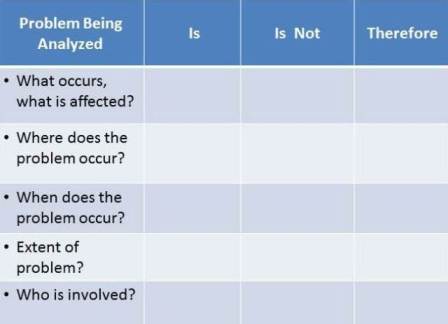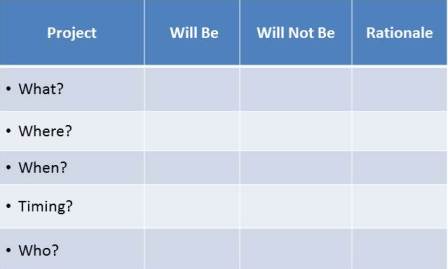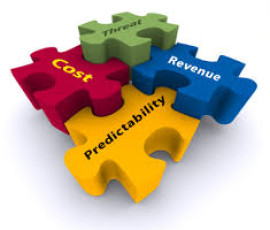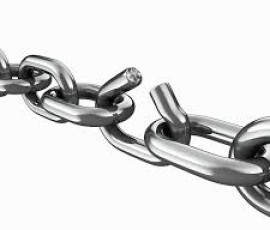Another Post in Our Series of DIY Consulting Tools We Share Every Other Tuesday!
 Being “Overwhelmed” is a common complaint we often get from clients after a brainstorming session. You can quickly reach a state of extreme over load when brainstorming a problem and its possible causes.
Being “Overwhelmed” is a common complaint we often get from clients after a brainstorming session. You can quickly reach a state of extreme over load when brainstorming a problem and its possible causes.
With so many ideas it’s difficult to identify what Dr. Joseph Juran called “the significant few among the insignificant many.”
Our response to clients is “Relax,” we got a tool for that!
A tool that comes in handy to identify the significant few among the insignificant many (besides Pareto Analysis) is the Is – Is Not Matrix.
“By isolating who, what, when, and where about a problem, you narrow your investigation to factors that have an impact and eliminate factors that do not have an impact.”
Overview of Is – Is Not Matrix Tool
The Is – Is Not Matrix identifies where to start looking for causes. By isolating who, what, when, and where about a problem, you narrow your investigation to factors that have an impact and eliminate factors that do not have an impact.
 As the name implies you begin by drawing out a matrix as shown here.
As the name implies you begin by drawing out a matrix as shown here.
Then, go thru the following five (5) step process:
1. Describe the problem in the upper left hand corner. Use general terms so that everyone clearly understands the problem.
2. Use the “Is” column of the matrix to describe what did or does occur.
- Determine what objects are affected and what exactly occurs.
- Determine where the problem occurs. This can be a geographic location, a physical location, or on an object.
- Determine when the problem occurs. When did it happen first? When since? What patterns of occurrence have you noticed?
- Determine the extent of the problem. How many objects or occurrences have problems? How many problems? How serious are they?
- Determine who is involved in the problem.
3. Use the “Is Not” column of the matrix to isolate the circumstances that could occur but did not.
4. Study the “Is” and “Is not” columns to identify what is different or unusual about the situations where the problem is as compared to where it is not. What stands out as being odd? Write your thoughts in the column headed “Therefore.”
5. Study the distinctions and look for links to the original problem.
Use The Is-Is Not Matrix Tool When
- You’re looking for causes of a problem or situation.
- You’re attempting to isolate factors that affect the situation from those factors that do not.
- You’re looking for a pattern in the circumstances surrounding the situation.
- You’re trying to identify a problem precisely by organizing available knowledge and ideas about the problem.
To Learn More
We recommend the following two (2) books for those of you interested in learning more:
- Quality Toolbox by Nancy R. Tague.
- The Rational Manager: A Systematic Approach to Problem Solving and Decision Making by
Helpful Hints
- The greater the level of detail in describing an occurrence and non-occurrence, the better the chance of determining the cause.
 A less common application of the Is – Is Not Matrix is in project planning. Organizing your ideas about the project upfront is a good way to prevent project creep. Here’s an example of how the Is – Is Not Matrix can be modified for project planning.
A less common application of the Is – Is Not Matrix is in project planning. Organizing your ideas about the project upfront is a good way to prevent project creep. Here’s an example of how the Is – Is Not Matrix can be modified for project planning.
 About the Author:
About the Author:
Gabriel Najera is the president & founder of the Najera Consulting Group. Gabriel is a frequent speaker to organizations. And, is a highly sought after advisor to corporate and nonprofit executives looking to develop a strategic thinking mindset.
Gabriel is available to speak to your organization. To inquire about scheduling Gabriel for an upcoming speaking engagement or to inquire about our consulting services, please click on this link.











I think that this is absolutely fabulous because not only do people get overloaded when they brainstorm, but there often isn’t any direction with the typical model of brainstorming that people use, so it ends up being a mess anyway without direction which doesn’t actually solve anything. In addition to this, not only do people get emotionally frustrated but this type of model serves to take that away by breaking everything down into its simplest form, which is a great place to start and branch out from.
The IS-IS NOT matrix is fabulous. I was introduced to it back in 2001, and found it to be a very effective problem solving tool. Since then I have held positions in a few other companies and discovered nobody has ever heard of it. Believe me I was very surprised at that.